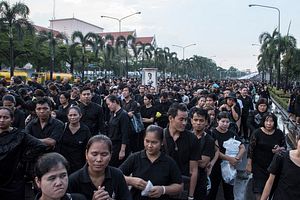Last week, hundreds of thousands of people from around the country came to pay their last respects to beloved late King Bhumibol in Bangkok. The nation’s longest-reigning monarch — whom many consider to be a father figure — was bid farewell in a lavish ceremony in the country’s capital on Thursday, marking an end to the year of mourning and more than a year since his passing on October 13, 2016.
In the days leading up to, and immediately following, the Royal Cremation of Thailand’s late King Bhumibol, it is estimated that more than 350,000 people from around the country made their way to Sanam Luang (the Royal Palace) in Bangkok. Due to the size of the crowds expected, some of those wishing to pay their respects to the longest-reigning monarch in Thai history came days in advance in order to secure access to areas closest to the Royal crematorium.
While preparations were months in the making, there was confusion and frustration as many were unable to get near to the crematorium where the daylong ceremony was held; thousands were forced instead to watch coverage live on television despite being only a few blocks away.
Mourners were met with blockades as the areas designated for public viewing of the ceremony quickly filled beyond capacity. Insistent on getting as close as possible, those outside the designated areas camped on sheets of plastic, using umbrellas to protect themselves from the harsh, late-morning sun, which later gave way to torrential rain owing to the waning monsoon season.
On narrow side streets, thousands of volunteers offered assistance to those unfamiliar with the ceremony layout or the city itself, since some had come from rural areas solely to be as close as possible during the cremation. While some residents and business owners provided free meals and cold drinks to those who had come to wait with little provisions, the majority of businesses — including all of the country’s 7-Eleven stores — closed their doors to observe what had been declared a national holiday.
The effect of the funeral — an unprecedented event in the country’s history — was far reaching. In an effort to manage the massive crowds, a number of replicas of the Royal crematorium were erected around Bangkok, as well as throughout the country, where members of the public could pay their respects. These too were often filled to capacity, forcing many to queue for hours outside. Unofficial and non-emergency vehicle traffic was prohibited within a wide radius of the Royal Palace and Crematorium, forcing many to make their way toward the ceremony on foot. Bangkok’s Chinatown became a highway of pedestrians making their way to and from the Royal Palace grounds. Nearby Khao San road — a backpacker and tourist mecca — was eerily silent as bars and nightclubs had shut their doors as a sign of respect.
Thai media was also affected, with television stations ordered in advance to refrain from upbeat programming before, during, and immediately following the cremation and to reduce the color of their broadcasts as a sign of respect to the late King. On the day of the cremation, channels were provided content by government run stations, to be broadcast for the duration of the cremation ceremony. Stations were permitted to return to scheduled programming at 6 a.m. on October 27. Newspapers filled pages with coverage and tributes to the late King and removed color from their websites.
While the official period of mourning has passed, it is unlikely that life will return to normal in Bangkok for some time as thousands still make their way toward the Palace grounds to pay their respects to the late King.
Cory Wright is a photographer/videographer currently based in southeast Asia. His work includes stories relating to conflict, migration, and the wider effects of incarceration and imprisonment. His website is www.coryjwright.com and his Instagram is @coryjwright


















































